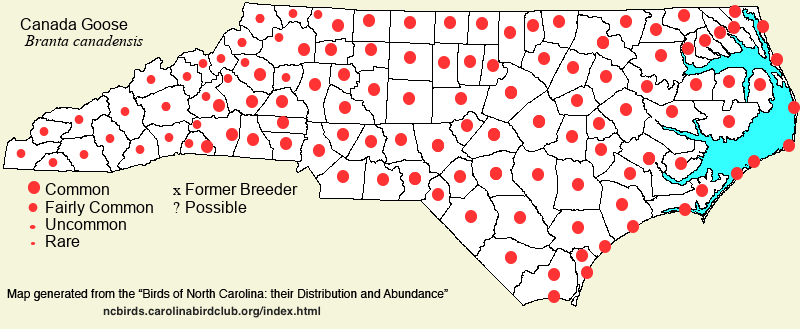 |  |
|
Canada Goose - Branta canadensis ANATIDAE Members: | Search Common: Search Scientific: |
|
|
|||||||
| General Comments | The very familiar Canada Goose was formerly a statewide winter resident only, with large flocks wintering in coastal areas. This population greatly declined in the past 30 years, owing mostly to "short-stopping" in states to the north of North Carolina. A concerted effort by wildlife organizations/clubs to establish a breeding, non-migratory, "hunt-able" goose population in the eastern counties, to replace the birds lost to "short-stopping", has yielded an explosion of feral goose populations all across the state. These birds nest in marshy vegetation at all types of ponds, lakes, and impoundments, and they forage on lawns, other grassy areas, marshes, and in ponds, often becoming pests. The native wintering population usually feeds in corn fields, other croplands, marshes, and in shallow water, often in brackish bays/sounds. | ||||||
| Breeding Status | Breeder; Feral | ||||||
| NC BRC List | Definitive | ||||||
| State Status | |||||||
| U.S. Status | |||||||
| State Rank | S5B,S5N | ||||||
| Global Rank | G5 | ||||||
| Coastal Plain | Formerly a common to abundant winter resident to the northern coast and tidewater areas, south to Dare and Hyde; uncommon southward and inland. Currently, a locally common (to only rarely locally abundant) winter resident, and fairly common to locally common summer resident, generally across the province. However, large wintering flocks are limited mostly to the tidewater regions south to Dare, Hyde, and Beaufort; thousands winter in Pamlico Sound, and at various refuges (such as Mattamuskeet). Normal dates for migrants: mid-Oct to late Mar. Peak count: 8,000 at Lake Mattamuskeet during the winter of 1972-73. | ||||||
| Piedmont | Formerly, an uncommon to very locally common winter resident; thousands wintered at Gaddy's Goose Pond (Anson) as late as the 1950's. Now, a common (at least locally) permanent resident, presumably augmented in numbers in winter. Peak counts: | ||||||
| Mountains | Formerly a rare to uncommon winter resident, but now a widespread, uncommon to locally common permanent resident, with numbers probably increased in winter. Peak counts: | ||||||
| Finding Tips |
The species is still easily found at nearly all National Wildlife Refuges, though it is now much less common than the Tundra Swan. Instead of thousands of Canadas gracing the air, you might now have to settle for dozens or a few hundreds. But, with the large feral population that now breeds across the state, one can generally find the birds more easily at a local park or extensive lawn than at a refuge, where they are often considered as pests. **** | ||||||
| Attribution | LeGrand[2025-01-29], LeGrand[2023-03-01], LeGrand[2011-12-30] | ||||||
| NC Map Map depicts all counties with a report (transient or resident) for the species. | Click on county for list of all known species. |
| NC Breeding Season Map Map depicts assumed breeding season abundance for the species. |  |